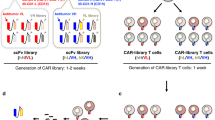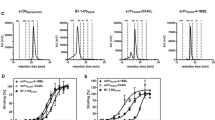Abstract
T cells require at least two signals for activation and clonal expansion. The first signal conferring specificity is initiated by interaction of the T cell receptor with peptide-bearing MHC molecules. The second, costimulatory signal can be provided by cell-surface molecules on antigen-presenting cells such as B7-1 (CD80) and B7-2 (CD86), which interact with CD28 on T cells. To direct the costimulatory B7-2 molecule to the surface of tumor cells we have constructed a chimeric fusion protein, which consists of the extracellular domain of human B7-2 fused to a single-chain antibody domain (scFv) specific for the ErbB2 protein, a type I growth factor receptor overexpressed in a high percentage of human adenocarcinomas. This B7-2225-scFv(FRP5) molecule, expressed in the yeast Pichia pastoris and purified from culture supernatants, binds to B7 counter-receptors and to ErbB2. B7-2225-scFv(FRP5) localizes specifically to the surface of ErbB2-expressing target cells, thereby providing a costimulatory signal, which results in enhanced proliferation of syngeneic T cells.
Similar content being viewed by others
Author information
Authors and Affiliations
Additional information
Accepted: 14 October 1997
Rights and permissions
About this article
Cite this article
Gerstmayer, B., Hoffmann, M., Altenschmidt, U. et al. Costimulation of T-cell proliferation by a chimeric B7-antibody fusion protein. Cancer Immunol Immunother 45, 156–158 (1997). https://doi.org/10.1007/s002620050421
Issue Date:
DOI: https://doi.org/10.1007/s002620050421




